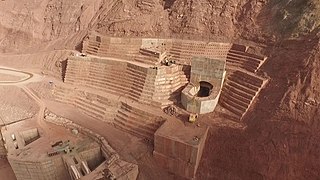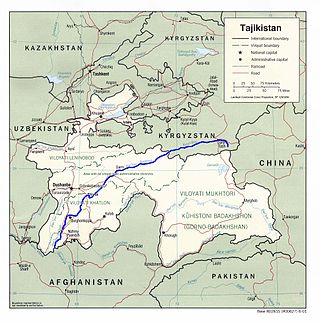Related Research Articles

Tajikistan, officially the Republic of Tajikistan, is a landlocked country in Central Asia. It has an area of 142,326 km2 (54,952 sq mi) and an estimated population of 9,750,065 people. Dushanbe is the country's capital and largest city. It is bordered by Afghanistan to the south, Uzbekistan to the west, Kyrgyzstan to the north, and China to the east. It is separated narrowly from Pakistan by Afghanistan's Wakhan Corridor. Tajiks form the ethnic majority in the country, and the historical Tajik homeland lies in present-day Tajikistan as well as parts of Afghanistan and Uzbekistan.

The economy of Tajikistan is dependent upon agriculture and services. Since independence, Tajikistan has gradually followed the path of transition economy, reforming its economic policies. With foreign revenue precariously dependent upon exports of cotton and aluminium, the economy is highly vulnerable to external shocks. Tajikistan's economy also incorporates a massive black market, primarily focused on the drug trade with Afghanistan. Heroin trafficking in Tajikistan is estimated to be equivalent to 30-50% of national GDP as of 2012.

Tajiks are a Persian-speaking Iranian ethnic group native to Central Asia, living primarily in Afghanistan, Tajikistan, and Uzbekistan. Tajiks are the largest ethnicity in Tajikistan, and the second-largest in Afghanistan and Uzbekistan. They speak varieties of Persian, a Western Iranian language. In Tajikistan, since the 1939 Soviet census, its small Pamiri and Yaghnobi ethnic groups are included as Tajiks. In China, the term is used to refer to its Pamiri ethnic groups, the Tajiks of Xinjiang, who speak the Eastern Iranian Pamiri languages. In Afghanistan, the Pamiris are counted as a separate ethnic group.

Dushanbe is the capital and largest city of Tajikistan. As of January 2022, Dushanbe had a population of 1,201,800 and that population was largely Tajik. Until 1929, the city was known in Russian as Dyushambe, and from 1929 to 1961 as Stalinabad, after Joseph Stalin. Dushanbe is located in the Gissar Valley, bounded by the Gissar Range in the north and east and the Babatag, Aktau, Rangontau and Karatau mountains in the south, and has an elevation of 750–930 m. The city is divided into four districts, all named after Persian historical figures: Ismail Samani, Avicenna, Ferdowsi, and Shah Mansur.

The Roghun Dam is an embankment dam under construction on the Vakhsh River in southern Tajikistan. The dam is situated 110 km from Dushanbe. It is one of the planned hydroelectric power plants of Vakhsh Cascade.

The Vakhsh, also known as the Surkhob, in north-central Tajikistan, and the Kyzyl-Suu, in Kyrgyzstan, is a Central Asian river, and one of the main rivers of Tajikistan. It is a tributary of the Amu Darya river.
Environmental issues in Tajikistan include concentrations of agricultural chemicals and salts in the soil and groundwater, poor management of water resources, and soil erosion. Additionally, because of inadequate sanitation facilities, untreated industrial waste and sewage combine with agricultural runoff to cause water pollution in the Aral Sea Basin. Soviet-Era mining operations in Tajikistan extracted and processed uranium, gold, antimony, tungsten, mercury, and molybdenum, each of which is known to leave toxic waste that also threatens water quality. Pockets of high air pollution caused by industry and motor vehicles have resulted in Tajikistan ranking 133rd in the world in greenhouse gas emissions. Air pollution is a particular problem during times of the year when atmospheric conditions hold industrial and vehicle emissions close to the surface in urban areas. In summer, dust and sand from the deserts of Uzbekistan and Turkmenistan cause air pollution across the entire southwestern lowland region.
For solar power, South Asia has the ideal combination of both high solar insolation and a high density of potential customers.

The 2008 Central Asia energy crisis was an energy shortage in Central Asia, which, combined with the severe weather of the 2007-08 winter and high prices for food and fuel, caused considerable hardship for many. The abnormally cold weather pushed demand up for electricity, exacerbating the crisis. The situation was most dire in Tajikistan. An international appeal was made by the United Nations, NGOs, and the Red Cross and Red Crescent for around US$25 million to assist the government. At the time, The UN warned that millions face starvation during the 2008-09 winter.

Football Club Barkchi Hisor formerly known as Barqi Tojik Hisor is football club based in Hisor in Tajikistan. They currently play in the top division of the country, and formerly played in the Soviet Second League.

Sangtuda 1 Hydroelectric Power Plant is a hydroelectric power plant, located on the Vakhsh River in Tajikistan. Construction commenced during the Soviet period in the 1980s, but halted in the beginning of the 1990s due to lack of financing when the station was about 20% complete. An agreement with Russia allowed to restart the construction, with four units entering service in 2008–2009. The plant was officially commissioned on 31 July 2009. Once working at full capacity, the plant will provide around 12% of Tajikistan's electricity output.
Sangtuda 2 Hydroelectric Power Plant is a Tajik hydroelectric power plant on the Vakhsh River.

Energy in Afghanistan is provided by hydropower followed by fossil fuel and solar power. Currently, less than 50% of Afghanistan's population has access to electricity. This covers the major cities in the country. Many rural areas do not have access to adequate electricity but this should change after the major CASA-1000 project is completed.
Central Electricity Regulatory Commission (CERC), a key regulator of power sector in India, is a statutory body functioning with quasi-judicial status under sec – 76 of the Electricity Act 2003. CERC was initially constituted on 24 July 1998 under the Ministry of Power's Electricity Regulatory Commissions Act, 1998 for rationalization of electricity tariffs, transparent policies regarding subsidies, promotion of efficient and environmentally benign policies, and for matters connected Electricity Tariff regulation. CERC was instituted primarily to regulate the tariff of Power Generating companies owned or controlled by the government of India, and any other generating company which has a composite scheme for power generation and interstate transmission of energy, including tariffs of generating companies.
Barqi is a village in Tabadkan Rural District, in the Central District of Mashhad County, Razavi Khorasan Province, Iran. At the 2006 census, its population was 651, in 168 families.
Tojikiston Soveti, also known as Dushanbe Tojikiston Soveti, was a newspaper published in Dushanbe, Tajikistan. It was published during the Soviet Union period, published between 1955 and 1991. The paper, run by the central committee of the Communist Party of Tajikistan, was a continuation of the earlier papers Idi Tojik and Bedorii Tojik (1925-28), and Tojikistoni Surkh (1928-1955).
The Golovnaya Dam is an earth-fill embankment dam on the Vakhsh River just east of Sarband in Khatlon Province, Tajikistan. It serves to provide water to a system of irrigation canals and generate hydroelectric power. The first generator was commissioned in 1962 and the last in 1963. Between 1984 and 1989 three of the Kaplan turbines were upgraded from 35 MW to 45 MW. Two of the turbines in the 240 MW power station discharge water into a canal on the left bank of the river. Water from this canal serves to irrigate but also supplies the 29.9 MW Perepadnaya and 15.1 MW Centralnaya Hydroelectric Power Plants located further down. The reservoir has a design storage volume of 96,000,000 m3 (78,000 acre⋅ft) by an estimated 80 percent of this is now silt.
The Central Asia-South Asia power project, commonly known by the acronym CASA-1000, is a $1.16 billion project currently under construction that will allow for the export of surplus hydroelectricity from Kyrgyzstan and Tajikistan to Afghanistan and Pakistan. Groundbreaking for the project took place in May 2016 by leaders of the four nations. The entire project is expected to be completed by 2025.
Barki or Barqi may refer to
Ivan-Tojik is a jamoat in north-west Tajikistan. It is located in Kuhistoni Mastchoh District in Sughd Region. The jamoat has a total population of 13,578 (2015). It consists of 18 villages, including Padrokh, Esizi Poyon, Hadishahr, Mehron and Ustung.
References
- ↑ "ADB grants $122 million grant to Tajikistan". New Europe. 2010-09-26. Retrieved 2010-11-13.[ permanent dead link ]
- ↑ Ergasheva, Zarina (2010-10-28). "Barqi Tojik: Electricity rationing will no be so strict this winter". ASIA-Plus. Retrieved 2010-11-13.
- ↑ "Alstom Wins 500 kV Substation Project Using GIS Tech in Tajikistan". The Gazette of Central Asia. Satrapia. 7 Feb 2012. Retrieved 4 October 2012.